When determining the ideal moment to retire from Chevron, there are a number of aspects to consider, as we cover in our extensive retirement guide for Chevron employees. These variables include, among many others, changes in healthcare and benefits, interest rates, the new tax rates for 2024, inflation, and much more. Remember that we have no connection to Chevron. For more information, we advise getting in touch with your Chevron benefits department.

People must be made aware of any recent adjustments made by the IRS. The primary elements that are most likely to have an impact on corporate workers are:
-
The standard deduction for 2024 will rise to $21,900 for heads of household, $29,200 for joint filers, and $14,600 for single taxpayers and married filers filing separately.
-
Individuals who are blind or over 65 can increase their standard deduction by an extra $1,550. If you are not a surviving spouse or are not married, that amount increases to $1,950.
Corporate employees who operate remotely may be subject to double taxation on state taxes. Many workers returned home as a result of the pandemic, sometimes even leaving the state in which they were working. Many of the temporary relief provisions that several states had in place last year to prevent double taxation of income have since expired. Currently, a "special convenience of employer" regulation is only in place in six states: Delaware, Connecticut, Nebraska, New Jersey, New York, and Pennsylvania. Ask your tax advisor if there are any other alternatives to reduce the double taxation if you work remotely for a business entity and do not now reside in those states.
Contributions to retirement accounts: You can lower your tax liability by making contributions to your employer's 401(k) plan, and the maximum amount you can save has been raised for 2024. In 2024, the maximum contribution amount that people can make to their 401(k) plans will rise to $23,000, from $22,500 in 2023. For 2024, there will be an increase in the income thresholds that determine who is eligible to make deductible contributions to traditional IRAs, roll over contributions to Roth IRAs, and claim the Saver's Credit. For workers who are 50 years of age or older, the maximum catch-up contribution will rise to $8,000.
You should be aware of the following significant changes to the Earned Income Tax Credit (EITC) if you are a taxpayer who works for a corporation:
-
For qualifying taxpayers with three or more qualifying children, the maximum Earned Income Tax Credit amount for tax year 2024 is $7,830, up from $7,430 for tax year 2023.
-
Those who are married and file separately may be eligible: If you satisfy certain requirements, you may be eligible to claim the EITC as a married filing separately. In past years, this wasn't offered.
Cash charitable contribution deduction: The special deduction that let individuals who are not itemizers to claim a deduction of up to $300 (or $600 for married couples filing jointly) for cash gifts to approved charities has ended.
Changes to the Child Tax Credit
-
For each eligible child, the maximum tax credit is $2,000. Furthermore, unlike in 2023, you are not eligible to get a portion of the credit in advance.
-
If your adjusted gross income is less than $200,000 if you're filing singly or less than $400,000 if you're filing a joint return with a spouse, you qualify for the Child Tax Credit as a parent or guardian.
-
A partial refundability of 80% that applies to people whose tax liability is less than the credit amount.
2024 Tax Brackets

Over time, inflation diminishes buying power because rising prices result in a basket of products becoming more expensive. You will need to account for increasing costs in your plan if you want to keep your retirement quality of living the same when you leave your business. The Federal Reserve targets an annual inflation rate of 2%, but in 2023 it reached a whopping 4.9%. a significant rise above the 1.4% in 2020. Even though costs have increased significantly overall, there are certain areas, like healthcare, to be mindful of if you are close to or already retired from your employer. Medicare serves as the primary health insurance for many business retirees, and in 2023, the out-of-pocket cost of such coverage is expected to rise by 5% to 14%. The cost of over-the-counter drugs is expected to rise by at least 7% in addition to Medicare increases. In their 2022 research, the Employee Benefit Research Institute (ERBI) discovered that, in order to pay for their average prescription expenses in retirement, a couple would need to save $296,000. All of these elements must be taken into account when creating a comprehensive retirement plan from your employer.
*Source: IRS.gov, Yahoo, Bankrate
Featured Video
Articles you may find interesting:
- Corporate Employees: 8 Factors When Choosing a Mutual Fund
- Use of Escrow Accounts: Divorce
- Medicare Open Enrollment for Corporate Employees: Cost Changes in 2024!
- Stages of Retirement for Corporate Employees
- 7 Things to Consider Before Leaving Your Company
- How Are Workers Impacted by Inflation & Rising Interest Rates?
- Lump-Sum vs Annuity and Rising Interest Rates
- Internal Revenue Code Section 409A (Governing Nonqualified Deferred Compensation Plans)
- Corporate Employees: Do NOT Believe These 6 Retirement Myths!
- 401K, Social Security, Pension – How to Maximize Your Options
- Have You Looked at Your 401(k) Plan Recently?
- 11 Questions You Should Ask Yourself When Planning for Retirement
- Worst Month of Layoffs In Over a Year!
- Corporate Employees: 8 Factors When Choosing a Mutual Fund
- Use of Escrow Accounts: Divorce
- Medicare Open Enrollment for Corporate Employees: Cost Changes in 2024!
- Stages of Retirement for Corporate Employees
- 7 Things to Consider Before Leaving Your Company
- How Are Workers Impacted by Inflation & Rising Interest Rates?
- Lump-Sum vs Annuity and Rising Interest Rates
- Internal Revenue Code Section 409A (Governing Nonqualified Deferred Compensation Plans)
- Corporate Employees: Do NOT Believe These 6 Retirement Myths!
- 401K, Social Security, Pension – How to Maximize Your Options
- Have You Looked at Your 401(k) Plan Recently?
- 11 Questions You Should Ask Yourself When Planning for Retirement
- Worst Month of Layoffs In Over a Year!

Retirement planning is a verb. And regardless of age, you have to act consistently.
The majority of Americans actually don't know how much money they should save or how much income they'll require.
Regardless of your age or where you are in the preparation process, we hope this guide will provide you with a clear understanding of the actions to take and resources to make your transition from your employer to retirement as easy as possible while maximizing your benefits.
You don't have the time or experience to determine whether you're accumulating retirement funds that will endure after leaving your job, even though you know you should be saving and investing because time is on your side the sooner you start.
'A separate study by Russell Investments, a large money management firm, came to a similar conclusion . Russell estimates a good financial advisor can increase investor returns by 3.75 percent.'
Source: Is it Worth the Money to Hire a Financial Advisor?, the balance, 202
It is important to begin saving as soon as possible. Compounding has the potential to significantly affect your future savings if you have time on your side. Furthermore, it's crucial to keep up with and optimize your 401(k) plan contributions once you've gotten started.
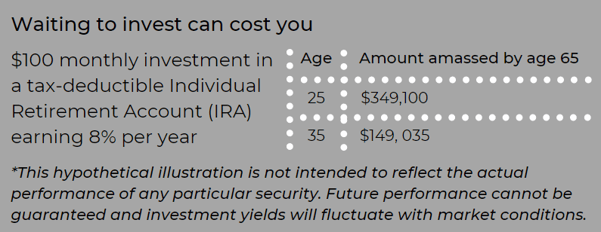
Choosing to invest in your company's retirement plan can result in a 79% potential increase in wealth at age 65 over a 20-year timeframe.
*Source: Bridging the Gap Between 401(k) Sponsors and Participants, T.Rowe Price, 2020
Saving for college vs retirement is one of the traditional planning conundrums. The majority of financial advisers would advise you that your main focus should be retiring from your employer, as you will be responsible for funding your own retirement while your child can typically receive financial assistance.
Our recommendations for retirement savings always take into account your particular financial status and aspirations. Nonetheless, during your 30s and 40s, think about setting aside at least 10% of your income for retirement funds. Maximizing your company's contribution match should be a goal, provided that your unique situation permits.
You're ideally in your prime earning years as you approach your 50s and 60s, with some of your biggest expenses—like a mortgage or raising children—either behind you or about to go. Now could be a good time to see whether you can increase your retirement savings target to 20% or higher of your income. This may be the last chance that many individuals have to put money down.
Employees fifty years of age or over have the option to contribute a maximum of $23,000 to their retirement 401(k) in 2024. After they reach this amount, they can make extra $7,500 in catch-up contributions. Every year, these caps are revised to account for inflation.
If you’re a Chevron employee over 50, you may be eligible to use a catch-up contribution within your IRA.
Why are 401(k)s and matching contributions so popular?
You have the opportunity to benefit from these retirement savings vehicles in three key ways:
-
Growth prospects that compound (as seen above)
-
Prospects for reducing taxes
-
Comparing contributions
Due to their failure to reach the minimum contribution criteria, sadly, a large number of people are not fully utilizing their company's match.
The Principal Financial Group revealed in a 2022 study that 62% of employees thought business 401(k) matches were very crucial for achieving retirement objectives.
Despite 58% of eligible employees participating in a 401(k) plan, 61% of them made contributions below $5,000 in the previous year, according to Bank of America's "2022 Financial Life Benefit Impact Report".
Additionally, the study discovered that less than 10% of participants' contributions exceeded IRS Section 402(g)'s $23,000 cap on elective deferrals for 2024.
A 2020 Financial Engines study titled "Missing Out: How Much Employer 401(k) Matching Contributions Do Employees Leave on the Table?" found that workers who don't take full advantage of the employer match usually leave $1,336 in additional retirement savings on the table annually.
If you pay 2% of your salary to your plan and your employer matches up to 3% of that amount, for instance, you aren't utilizing the entire company match. Your employer would now match 3% (up to the maximum) of your contributions, making the total combined contribution 6% of your pay. All you would have to do was increase your contribution by 1%. You're not wasting money if you do this.

It might be challenging to decide what to do with your hard-earned retirement savings, whether you're moving jobs or retiring from your employer. The bulk of your retirement assets may be in a company-sponsored plan, such a 401(k) or pension, but how much do you actually know about the plan's operation?
There are several regulations that differ between retirement plans; these include early withdrawal penalties, interest rate effects, age restrictions, and intricate tax implications.
The secret to a successful retirement plan spending strategy is to increase your investment balance while lowering taxes. The Retirement Group can assist you in making the most out of your company's 401(k) plan and comprehending how it fits into your entire financial plan.
Employees are significantly more likely to get their income from their workplace's defined contribution (DC) retirement plans.
'Getting help and leveraging the financial planning tools and resources your company
makes available can help you understand whether you are on track, or need to
make adjustments to meet your long-term retirement goals...'
Source: Schwab 401(k) Survey Finds Savings Goals and Stress Levels on the Rise
The Chevron Pension Plan
Because the Chevron Pension Plan is complicated, it's critical to consult with an expert who is familiar with your plan.
-
If you vested when your work ended—that is, after five years of service or when you turned 65—you are qualified for benefits.
-
You must be a qualified employee or have an undistributed benefit in the Chevron Retirement Plan in order to participate.

-
A monthly Single Life Annuity is used to compute the benefit.
-
Depending on the legacy plan you were a part of, a different formula may apply if you were not a qualifying employee after the merger date.
-
Benefits are based on Monthly Age-65 Life Annuity if you become eligible after the merger date of your legacy plan.


Your average monthly earnings for the 36 consecutive months that your earnings are at their highest are your highest average earnings. This is usually equal to the total of the last 36 months divided by 36.
A separate average of the three-segment rates for the fifth, fourth, and third months prior to the start date of your annuity constitutes the applicable interest rate. The IRS uses regulations included in the Pension Protection Act of 2006 to determine the three-segment rates, which are based on the yields of corporate bonds with varying maturities: short-, mid-, and long-term.

The monthly average of your regular earnings for the 36 consecutive months that they are at their highest is your highest average earnings. This is often calculated by dividing the total of your last 36 months by 36.
The three-segment rates for the fifth, fourth, and third months prior to the start date of your annuity are separately averaged to determine the appropriate interest rate. The Pension Protection Act of 2006 includes standards that the IRS uses to determine the three-segment rates, which are based on the yields of corporate bonds with varying maturities: short-, mid-, and long-term.

On July 1, 2006, if you were an hourly employee at the Questa facility and were covered by the Unocal Retirement Plan (URP) provisions outlined in subsection 14.5 and Appendix F prior to the URP's merger into the CRP, you automatically became a Participant of Supplement VV of the CRP (as detailed in a separate SPD).

Companies can and do make mistakes:
-
Send in your social security statement to have it adjusted if the firm over-projects the offset; this could result in a bigger company annuity or lump-sum payout.
-
If the business underestimates the offset, retain the greater gain.
-
If you are sending in your statement without first speaking with an advisor with experience with Chevron, proceed with caution.
Payment Options:

Single Life Annuity
-
All potential modes of payment under the plan are sourced from the monthly Single Life Annuity benefit.
-
Pays a set monthly sum for the duration of the retiree's life.
-
Your beneficiary might be eligible for a death benefit.
-
If a vested employee passes away before their employment ends or they begin receiving benefits, they will be entitled to a death benefit.
Lump-Sum Options (Most Oil Companies Offer a Lump Sum)
-
The entire annuity you would have received as a single life annuity during your lifetime is actuarially equal to the lump-sum payout.
-
Depending on your age and the interest rate that was in force on the date that your annuity began, as determined by actuarial factors.
-
Benefits for death are not payable.
NOTE: Lump-Sum vs. Annuity: Your lump-sum payout will rise as interest rates fall.
Life & Term-Certain Annuity Option
-
Less than an Annuity for a Single Life.
-
5, 10, or 15 years at a specific time.
-
The remaining payments will be converted actuarially to a lump amount if you have more than one beneficiary or if your beneficiary is your estate or trust.
-
Benefits for death are not payable.
Joint & Survivor Annuity
-
Your joint annuitant receives a portion of your monthly benefit for as long as they live after you pass away.
If both of these hold true, the benefit calculation is subject to reduction factors:
-
A >53% Joint and Survivor Annuity is what you choose.
-
Someone who is over ten years younger than you and is not your spouse is your joint annuitant.
Death of Joint Annuitant
-
If the joint annuitant passes away within five years of the start date, there may be an increase in payments.

Uniform Income
-
Receive the same amount of income before and after obtaining social security payments.
-
Before the age of 62, employees earn a higher monthly annuity from the plan.
- After age 62, when Social Security benefits become available, employees get a lower monthly annuity from the plan.Each company's Uniform Income regulations vary. To learn more about the restrictions for your specific plan, see your company's SPD or an advisor.
Review your Chevron SPD for the Immediate Commencement Discount Factor Table.
At this point in the economic cycle, there is a significant interest rate risk.
Keep in mind that annuities normally do not provide inflation protection, but some employees prefer the certainty of a monthly income. To compensate for not electing the lump-sum, select the single annuity option and purchase a life insurance policy (protection for spouse and children) to maximize your pension income.
If you are considering what to do with your pension, consult with a counselor to determine whether you should take a lump sum or an annuity, and when. What is best for your family?
You should use the tools and resources in The Retirement Group's e-Book library, such as the Retirekit, on a regular basis to simulate your pension benefit in retirement and the pension payment alternatives accessible to you.
You can also reach a Chevron-focused advisor at The Retirement Group at (800)-900-5867. We will connect you with a Chevron-certified advisor who will assist you in beginning the retirement process and informing you of your payment.
Note: We recommend that you read the Chevron Summary Plan Description. The Retirement Group is not affiliated with Chevron.
Next Step:
-
Determine whether to get the Chevron pension as a lump payment or annuity.
-
How do interest rates influence your decision?
-
Use the "Retirekit" to learn about cash flow, interest rates, and which pension choice would be best for you in retirement.
-
As you approach your retirement date, contact a Chevron-focused advisor at The Retirement Group and read Chevron's SPD Summary to begin your retirement planning.
-
Chevron will require you to produce documentation of birth, marriage, divorce, Social Security number, and other information for yourself and your spouse/legally recognized partner.
-
If your pension program requires it, Chevron may provide a Beneficiary Designation online tool where you can amend your beneficiary selections. For more information, please refer to Chevron's SPD.
Lump-Sum vs. Annuity
Retirees who are eligible for a pension are frequently given the option of taking the pension payments for life or receiving a lump-sum dollar amount for the "equivalent" value of the pension - with the expectation that you will then take the money (rolling it over to an IRA), invest it, and generate your own cash flows by taking systematic withdrawals from your company throughout retirement.
The benefit of preserving the pension is that the payments are guaranteed to continue indefinitely (as long as the pension plan is in effect, viable, and does not default). Thus, whether you survive 10, 20, or 30 (or more!) years after leaving your company, you will not be concerned about outliving your money.
In contrast, choosing the lump-sum option allows you to invest, earn higher growth, and perhaps produce even more retirement income flow. Furthermore, if something happens to you, any unused account balance will be available to your surviving spouse or heirs. However, if you fail to invest the funds for sufficient development, the money may run out entirely, and you may regret not taking advantage of the pension's "income for life" guarantee.
Finally, the "risk" assessment that should be performed to determine whether you should choose the lump amount or the guaranteed lifetime payments that your business pension provides is determined by the type of return that must be created on that lump sum in order to match the annuity payments. After all, if it only takes a 1% to 2% return on the lump-sum to generate the same pension cash flows for a lifetime, there is little chance that you will outlive the lump-sum after leaving your firm, even if you withdraw it for life(10). However, if the pension payments can only be replaced with a higher and more risky rate of return, there is a bigger danger that those gains will not materialize and you would run out of funds.
Interest Rates and Life Expectancy
Many defined benefit plans, such as the Chevron pension plan, offer current and future retirees a lump sum payment or a monthly pension benefit. Your pension is computed using your last date of employment and the benefit start or commencement date. The benefit computation is based on your years of employment and final average salary. These, combined with a social security offset, are used to calculate your single-life annuity. All other types of pension payments are based on this value.
If you want to withdraw your pension in one lump sum, Chevron will compute the amount based on interest rates and your age. When interest rates rise or fall, the amount of your pension lump sum changes in the opposite direction. After falling considerably in 2020, interest rates began to rise following Covid. When you choose the month to begin your pension, Chevron calculates the rate utilized for the pension disbursement based on the previous three months. For example, if you want to retire and begin receiving your pension in June 2024, Chevron will apply the blended rate available from January 2024 to March 2024 (three months before your retirement date). This example depicts three months' worth of rates and how they are used to calculate your rates for various pension segments.
For example, if you start your pension in May 2024, the blended rate is the average of the rates in December 2023, January 2024, and February 2024.
For lump-sum conversions, the annuity is discounted to present value using the first segment rate for the first 5 years of planned payments, the second segment rate for the next 15 years of expected payments, and the third segment rate for all years of expected payments after 20 years.
Because pension pricing is dependent on interest calculations, even little changes in your retirement date might have a large financial impact on your pension due to monthly rate fluctuations.
The blended rates for June 2024 are currently 4.95%, 5.18%, and 5.34%, compared to May 2024 rates of 4.96%, 5.16%, and 5.27%. You will note that these rates are practically the same.
Everything else being equal, a higher interest rate results in a lesser lump payment. The precise changes depend on your age, but on average, a 1% change in interest rates can result in an 8% to 12% shift in lump sum values in the other direction. 
For illustration, a 1% increase in interest rates may result in a 10% drop in your pension. Someone with a $500,000 lump sum may see their lump sum decrease by around $50,000. For a $1,000,000 lump amount, it would be approximately $100,000 less.
The rates are revised regularly, giving you month-to-month alternatives for starting your pension if you have retired. You are not required to begin your pension upon retirement. You have the option of deferring it. This could be advantageous if interest rates are falling and/or you are under the age of 60. If you draw your pension before the age of 60, you will incur age penalties and will not receive the full amount of your pension payment.
Given the current rising interest rate environment, it is strongly advised that you discuss your alternatives with The Retirement Group and allow us to monitor rates and keep you up to date on monthly changes. We can conduct a free Cash Flow Analysis to show you how different retirement dates might work out.
It is crucial to remember that a pension annuity may be a superior fit, regardless of how appealing the pension lump amount appears. Every circumstance is unique, and a Cash Flow Analysis enables you to assess various pension possibilities.
Non-Qualified Executive Compensation Plans
The Deferred Compensation Plan (DCP)
This plan enables executives with PSG 28 or higher to defer a portion of their salary throughout employment years. After retirement or separation, accrued amounts can be distributed as a lump sum or in annual payments (for up to ten years). Distributions are subject to regular income tax rates in the year they are received.
Retirement Restoration Plans (RRPs)
This plan is for executives with a PSG of 26 or above and provides an additional retirement benefit in the form of a lump amount or annual payments (for up to ten years). The decision on how to share the proceeds must be made during enrolling. The default payment method is a lump sum, which may not be the most tax-efficient. Distributions are subject to regular income tax rates in the year they are received. The RRP is distributed at least five quarters after retirement from service. The distribution can be adjusted at least twelve months before the first payment, but the payment is deferred for at least five years. The RRP amount also increases at the ten-year Treasury rate.
Take Action: If you are unsure about your pension planning, please call us at (800) 900-5867 and one of our Chevron-focused experts will speak with you.

When was the last time you evaluated or made changes to your company's 401(k) plan account?
If it's been a while, you are not alone. Every year, 73% of plan participants devote fewer than five hours to exploring their 401(k) investment options, and the situation is considerably worse when it comes to account changes.
If you have balances in your 401(k) plan at the time you retire, you will receive a Participant Distribution Notice via mail. This message will display the current value that you are eligible to receive from each plan and explain your distribution options. It will also explain what you must do to obtain your final allocation. For additional information, please call The Retirement Group at (800)-900-5867, and we will put you in touch with a specialist retirement-focused advisor.
Next Step:
- Receive your Participant Distribution Notice and Special Tax Notice for Plan Payments. These mailings will assist you understand your options and the potential federal tax implications for your vested account balance.
- "What has Worked in Investing" & "8 Tenets when picking a Mutual Fund" .
- To learn more about your distribution alternatives, call The Retirement Group at (800)-900-5867. More information on "Rollover Strategies for 401(k)s" is available in our e-book. If you need to amend your beneficiary designations, use the Online Beneficiary Designation tool.
More than half of plan participants say they lack the time, desire, or understanding required to manage their 401(k) portfolio. But the benefits of seeking assistance extend beyond convenience. According to Charles Schwab's research, plan participants who receive investment advice tend to have portfolios that perform better: The annual performance difference between those who receive assistance and those who do not is 3.32%, net of expenses. This suggests that a 45-year-old person may increase their wealth by 79% by the age of 65 simply by contacting an advisor. That's a significant difference.
 Getting assistance can be the key to improved outcomes across the 401(k) board.
Getting assistance can be the key to improved outcomes across the 401(k) board.A Charles Schwab study discovered some favorable results common to those who sought independent professional guidance. They include:
- Improved savings rates - 70% of individuals who received 401(k) guidance raised their contributions.
- Increased diversification - Participants who managed their own portfolios invested in an average of just under four asset classes, whereas those in advice-based portfolios invested in at least eight asset classes.
- Increased chances of staying the course - Receiving assistance enhanced participants' odds of sticking to their investing goals, making them less reactive during unpredictable market conditions and more likely to stick with their original 401(k) investments during a downturn. accomplish not try to accomplish it alone.
Seek assistance with your company's 401(k) plan investments. Your nest egg will thank you.
In general, you can withdraw funds from your account while still employed with your firm, subject to the conditions outlined below.
Certain withdrawals are subject to standard federal income tax, and if you're under age 59½, you may also face an additional 10% penalty tax. You can check if you're qualified for a withdrawal and then request one online or by phoning your company's Benefits Center.
Rolling Over Your 401(K)
An in-service dividend can be rolled over to an IRA if the plan participant is under 72 years old. A straight rollover avoids both the 10% early withdrawal penalty and the necessary 20% tax withholding. More information, including potential rollover and withdrawal limits, can be found in your company's plan summary.
Because a withdrawal permanently decreases your retirement savings and is taxed, you should always consider obtaining a loan from the plan rather than withdrawing to satisfy your financial needs. Loans, unlike withdrawals, must be repaid and are tax-free (unless you fail to repay them). In other situations, such as hardship withdrawals, you are not permitted to make a withdrawal unless you have taken out the maximum loan available under the employer plan.
You should also be aware that your company's plan administrator reserves the right to change the regulations governing withdrawals at any moment, and may further restrict or limit the availability of withdrawals for administrative or other purposes. All plan participants shall be made aware of any such limits, which apply equally to all business workers.
Borrow from your 401(k)
Should you? Perhaps you lose your job with your firm, have a serious health issue, or have another reason for needing a large sum of money. Banks require excessive paperwork for personal loans, credit cards have high interest rates, and you may consider deferring retirement from your firm to compensate.
We understand how you feel: this is your money, and you need it now. However, consider how this may have an undesirable effect on your retirement plans after leaving your job.
Consider these facts while determining whether to borrow from your 401(k). You can:
-
You lose the opportunity for development on the money you borrowed.
-
If you leave your company, you will have to deal with payback and tax concerns.
-
If you leave your company, you may face repayment and tax concerns.
Net Unrealized Appreciation (NUA)

When you qualify for a distribution, you have three choices:
-
Roll over your eligible plan to an IRA and continue to defer taxes.
-
Take a distribution and pay regular income taxes on the entire amount.
-
Take advantage of NUA and profit from a more favorable tax structure for gains.
How does Net Unrealized Appreciation Work?
First, an employee must be eligible for a distribution from a qualified company-sponsored plan. At retirement or age 59 1⁄2, employees often get a 'lump-sum' distribution from their plan, which distributes all assets over a year period. The portion of the plan that consists of mutual funds and other investments can be transferred to an IRA for additional tax deferral. The highly appreciated firm shares is subsequently moved into a non-retirement account.
The tax benefit occurs when you transfer business stock from a tax-deferred account to a taxable account. At this point, you apply NUA and pay ordinary income tax on the cost basis of your shares. The stock's appreciated value above its basis is taxed at the lower long-term capital gains rate, which is now 15%, rather than the higher ordinary income tax. This could result in savings of over 30%.
As a Chevron employee, you may want to learn about NUA from a financial counselor.
IRA Withdrawal
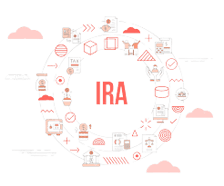
When you qualify for a distribution, you will have three options:
Your retirement assets could include IRAs, 401(k)s, taxable accounts, and others.
So, what is the best approach to withdraw your retirement income after leaving your company?
Consider fulfilling your retirement income demands by withdrawing from taxable assets rather than tax-deferred investments.
This may help your company's retirement assets last longer by allowing them to grow tax-deferred.
You should also prepare to take the required minimum distributions (RMDs) from any company-sponsored retirement plans, as well as traditional or rollover IRA accounts.
This is due to IRS guidelines for 2024, which state that you must begin taking distributions from these types of accounts when you reach age 73. Beginning in 2023, the excise tax on each dollar of under-distributed RMD will be decreased by 50% to 25%.
There is new legislation that allows account owners to postpone their first RMD until April 1 of the calendar year in which they reach age 73 or, in a company retirement plan, retire.
Two flexible distribution alternatives for your IRA
When it comes to drawing on your IRA for income or taking RMDs, you have a few options. IRA distributions are taxed and may have penalties for those under 59½.
Partial withdrawals: You may remove any amount from your IRA at any time. If you're 73 or older, you must withdraw money from one or more IRAs to pay your annual RMD.
Systematic withdrawal plans: Set up regular, automatic withdrawals from your IRA based on your income needs once you retire from your company. If you are under 59½, you may face a 10% early withdrawal penalty (unless your withdrawal plan meets Code Section 72(t) criteria).
Your tax advisor can assist you in understanding distribution alternatives, determining RMD obligations, calculating RMDs, and establishing a systematic withdrawal strategy.

HSA's
Health Savings Accounts (HSAs) are frequently praised for their effectiveness in managing healthcare costs, particularly for people with high-deductible health plans. However, their advantages go beyond medical cost management, establishing HSAs as a potentially superior retirement savings vehicle compared to typical retirement plans such as 401(k)s, particularly after employer matching contributions are exhausted.
Understanding HSAs
HSAs are tax-advantaged accounts intended for people who have high-deductible health insurance policies. For 2024, the IRS classifies high-deductible plans as having a minimum deductible of $1,600 for individuals and $3,200 for families. HSAs provide pre-tax contributions, tax-free investment growth, and tax-free withdrawals for qualified medical costs, making them a triple-tax-advantaged account.
HSAs' annual contribution limits in 2024 are $4,150 for individuals and $8,300 for families, with an additional $1,000 allowed for those 55 and older. Unlike Flexible Spending Accounts (FSAs), HSA funds do not expire at the end of the year; they grow and can be carried forward indefinitely.
Comparing HSAs versus 401(k)s after Matching
Once an employer's maximum 401(k) match is reached, additional contributions result in less immediate financial rewards. This is where HSAs can serve as a strategic complement. 401(k)s provide tax-deferred growth and tax-deductible contributions, but withdrawals are taxed. In contrast, HSAs allow for tax-free withdrawals for medical expenses, which account for a major amount of retirement costs.
HSA as a Retirement Tool.
After age 65, the HSA stretches its muscles as a powerful retirement tool. Funds can be withdrawn for any reason, subject only to standard income tax if spent for non-medical expenses. This flexibility is similar to that of regular retirement plans, but it also includes tax-free withdrawals for medical bills, which is a substantial benefit given escalating healthcare costs in retirement.
Furthermore, unlike 401(k)s and Traditional IRAs, HSAs have no Required Minimum Distributions (RMDs), giving you more flexibility over your tax planning in retirement. This makes HSAs especially appealing to those who may not need to access their funds immediately after retirement or who want to reduce their taxable income.
Investment Strategy for HSAs.
Initially, it is prudent to invest conservatively in an HSA, with an emphasis on ensuring that there are enough liquid assets to cover the near-term deductible and other out-of-pocket medical expenses. However, if a financial cushion has been formed, using the HSA as a retirement account and investing in a diverse mix of equities and bonds can considerably improve the account's long-term growth potential.
Utilizing HSAs in retirement
In retirement, HSAs can cover a variety of expenses:
-
Healthcare Costs-Pre-Medicare: HSAs can cover healthcare costs to bridge you to Medicare.
-
Healthcare Costs After Medicare: HSAs can be used to pay for Medicare premiums as well as out-of-pocket medical expenses such as dental and eye treatment, which are frequently not covered by Medicare.
-
Long-term Care: Funds may be used for approved long-term care services and insurance payments.
-
Non-medical Expenses: After age 65, HSA funds can be used for non-medical expenses without penalty, but withdrawals are subject to income tax.
Conclusion
In conclusion, HSAs have distinct advantages that can make them a better alternative for retirement savings, especially once the benefits of 401(k) matching are fully realized. HSAs are an important component of a comprehensive retirement strategy because of their fund flexibility and tax advantages. Individuals can improve their financial health in retirement by strategically managing contributions and withdrawals, ensuring both medical and financial security.
Chevron Healthcare Options
Even after retirement, your Chevron health plan can help pay some of your medical bills. The plans you are eligible for are determined by whether you are over or under 65.
Healthcare Options for Retirees Under 65
Prior to the age of 65, you may continue to participate in Chevron's group medical coverage. This policy provides you and your spouse/domestic partner with the following coverage options:
-
Medical PPO Plan
-
High Deductible Plan
-
Medical HMO Plan
Coverage prices are based on your age and years of service.
Healthcare Options for Retirees Age 65 and Older
When you reach the age of 65, Chevron employees and their dependents are eligible for OneExchange, a private healthcare exchange.
Although your primary healthcare coverage will be provided by Medicare, OneExchange can supplement Medicare Part A and Part B. You may also be able to include Part D coverage.
With OneExchange, you may select from a variety of coverage rates and insurance companies based on your interests.
OneExchange services are paid via reimbursements to a Health Retirement Account (HRA). These funds have a time limit for use and are less flexible than monies in a Health Savings Account. HRA funds also earn no additional interest on the funds in the account, as opposed to HSAs, which allow funds to grow. If you have both an HRA and an HSA, it is suggested that you use the HRA funds for reimbursement before using the HSA funds.
Chevron Healthcare Company Covers Premiums
Chevron may cover a portion of your retirement healthcare premiums. Chevron considers your present age, retirement age, and eligible years of service when determining how much of your premiums are covered.
80 Point Formula - If you retired before January 1, 2005, and you were 50 or older with ten years of service, you would be eligible for the 80-point formula, which awards points based on the following formula:
Age plus years of qualified service equals points.
90 Point Formula - If you retired after January 1, 2005 or did not qualify for the 80-point formula, you are subject to the 90-point formula, which is based on the following formula:
Age plus years of qualified service equals points.
Chevron Benefits: Annual Enrollment
As mentioned in your Chevron SPD, annual registration for your Chevron benefits often occurs in the fall (for example, October 24 - November 15, 2019). Before the program begins, you will be mailed registration materials and an initial confirmation statement showing your benefits coverage to the address on file. You'll discover registration procedures, as well as information regarding your benefit selections and contribution levels. You will have the choice of maintaining the benefit coverage displayed on your initial confirmation statement or selecting benefits that better meet your needs. You can enroll in eBenefits to receive this information via email instead.
Next step:
-
Watch for your annual enrollment information in September/November.
-
Review your benefits information, and use the tools and services offered on the Chevron Benefits Center website.
-
Enroll in eBenefits.
Things to keep in mind:
-
47% of Americans say health care is their top economic issue.
-
Medical costs are the leading cause of bankruptcy in the United States.
-
Healthcare costs are the second highest expense for elderly Americans, trailing only housing.
Short-Term and Long-Term Disability
Short-Term: Depending on your plan, you may be eligible for short-term disability (STD) benefits.
Long-Term Disability: Your plan's long-term disability (LTD) benefits are intended to provide you with income if you are absent from work for six months or more due to an eligible sickness or injury.
What Happens If Your Employment with Your Company Ends?
Your life insurance coverage, as well as any optional coverage you acquire for your spouse/domestic partner and/or children, expires on the date your employment with your firm ends, unless it is due to disability. If you die within 31 days of your company's termination date, your beneficiary receives benefits for both your basic life insurance and any supplemental life insurance coverage you choose.
Note:
-
You may be able to change your life insurance to an individual policy or choose portability for any optional coverage.
-
If you cease paying additional contributions, your coverage will expire.
-
If you are at least 65 years old and pay for additional life insurance, the insurance company should send you literature in the mail explaining your options.
-
Make care to notify your beneficiaries. For more information, please refer to the Chevron SPD.
Beneficiary designations
As part of your company's retirement and estate planning, designate someone to receive the proceeds of your benefit programs in the case of your death. That is how Chevron will determine who should receive your ultimate salary and perks. This includes life insurance payouts, as well as any pension or savings balances you may have.
Next step:
-
When you depart from your company, make sure to notify your beneficiaries. Chevron should provide an online beneficiary designation form for life events such as death, marriage, divorce, childbirth, and adoption.
If you have any questions about your Chevron benefits, book a call with one of our Chevron-focused advisors.

Many retirees struggle to comprehend and claim Social Security, but determining the best ways to claim Social Security is critical to your retirement income planning. Social Security benefits are not intended to be the primary source of retirement income, but rather to supplement your total withdrawal strategy.
Knowing the fundamentals of Social Security and applying that knowledge to your advantage will help you collect the most benefit.
It is your duty to enroll in Medicare Parts A and B when you first become eligible, and you must remain enrolled to receive coverage for Medicare-eligible expenses. This also applies to your dependents who are qualified for Medicare benefits.
You should understand how your retiree medical plan selections and Medicare eligibility affect your plan alternatives. Before you resign from your employer, contact the Social Security Administration at 800-772-1213, your local Social Security Office, or ssa.gov.
They can assist you in determining your eligibility, enrolling you and/or your eligible dependents in Medicare, and providing information about other government programs. Please call us if you need additional information about Social Security.
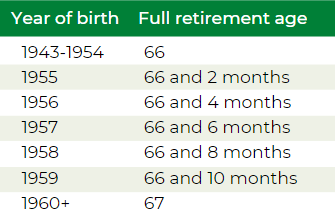
Before retiring from your company, check the status of your Social Security benefits. Contact the United States Social Security Administration, your local Social Security office, or go to ssa.gov.
Are you currently eligible for Medicare or will you be soon?
If you or your dependents become eligible after leaving your telecom industry company, Medicare normally takes over as your primary coverage as soon as they become eligible. This will have an impact on the medical benefits supplied by the firm.
When you initially become eligible for Medicare, you and your dependents must enroll in Parts A and B of the program. Medical and MH/SA benefits payable under the company-sponsored plan will be lowered by the sums Medicare Parts A and B would have paid, whether or not you enrolled in them.
For more information on benefit coordination, see your company's summary plan description.
If you or an eligible-dependant do not enroll in Medicare Parts A and B, your provider may bill you for amounts not covered by Medicare or your company's medical plan. This increases your out-of-pocket spending dramatically.

According to the Employee Benefit Research Institute (EBRI), Medicare only covers approximately 60% of an individual's medical expenses. This indicates that a 65-year-old couple with average prescription-drug expenses for their age will require $259,000 in savings to cover 90% of their healthcare costs. A single guy will need $124,000, whereas a single female, because to her longer life expectancy, will require $140,000.
Check the Chevron plan summary to discover if you are eligible for Medicare Parts A and B.
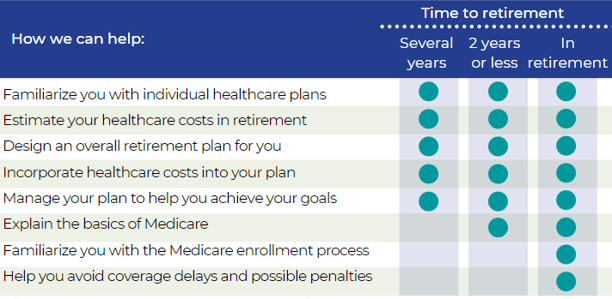
If you become Medicare-eligible for reasons other than age, you must contact Chevron's benefit center of your status.

28% of couples over the age of 53 will not experience happily ever after and until death do us part. Most couples save for decades, expecting they would retire together. Following a divorce, they must face the expenses of a pre- or post-retirement lifestyle while only having half of their savings.
If you're divorced or in the process of divorce, your ex-spouse(s) may be interested in a portion of your company's retirement benefits. Before you may begin your pension—and for each former spouse who may be interested—you must submit your firm with the necessary documentation:
-
A copy of the court-filed Judgment of Dissolution or Judgment of Divorce, together with any Marital Settlement Agreement (MSA)
-
A copy of the court's Qualified Domestic Relations Order (QDRO)
To avoid having your pension payout delayed or suspended, please provide your firm with any needed documentation. Please contact us for more information on options for dealing with divorce and its impact on your company's retirement benefits.
Regardless of how long or brief your marriage was, you must submit this evidence to your company's online pension center. *Source: The Retirement Group, "Retirement Plans - Benefits and Savings," U.S. Department of Labor, 2019, and "Generating Income That Will Last Throughout Retirement," Fidelity, 2019.
You can apply for a divorced spouse's benefit if the following conditions are met:
You're at least 62 years old.
You were married for at least ten years before the divorce.
You are presently unmarried.
Your ex-spouse is eligible for Social Security benefits.
Your individual Social Security benefit amount is lower than your spousal benefit amount, which is one-half of your ex's full benefit amount if claimed at Full Retirement Age (FRA).
Unlike a married pair, your ex-spouse does not need to have filed for Social Security before you may apply for your divorced spouse's benefit; however, this only applies if you've been divorced for at least two years and your ex is at least 62 years old. If your divorce occurred less than two years ago, your ex must be receiving benefits before you can register as a divorced spouse.
Divorce does not disqualify you for survivor benefits. You can claim a divorced spouse's survivor benefit if the following apply:
-
Your ex-spouse has died.
-
You are at least sixty years old.
-
You were married for at least ten years before the divorce.
-
You are single (or remarried after turning 60).
Are you going through a divorce?
If your divorce is not finalized by the time you retire from your company, you are still considered married. You have two choices:
-
Retire from your company before your divorce is finalized and opt for a combined pension of at least 50% with your spouse — or obtain your spouse's signed, notarized approval to a different election or lump amount.
-
Defer your retirement from your company until your divorce is finalized and you can supply the necessary divorce documentation*.

In the unfortunate event that you are unable to collect your work benefits, your survivor will be responsible for taking appropriate action.
What your survivor needs do:
-
Report your death. Your spouse, family member, or friend should contact your company's benefits service center as quickly as possible to report your death
-
Receive life insurance benefits. To get life insurance benefits, your spouse or other designated beneficiary must contact your company's benefits service center.
If you have a joint pension:
-
Start making joint pension contributions. The joint pension is not automatic. To begin receiving joint pension payments, your joint pensioner must complete and return the papers provided by your company's pension center.
-
Prepare financially to pay living expenditures. Your spouse will need to have enough funds to cover at least one month between the end of your company's pension payments and the start of his or her own pension payments.
If your survivor has medical coverage through your company:
-
Decide whether or not to keep your medical coverage.
-
If your survivor is enrolled as a dependent in your company's retiree medical coverage when you die, he or she must decide whether to continue it. Survivors must pay the entire monthly cost.

While you may be ready for some leisure and relaxation away from the stress and schedule of your full-time job with your company, it may make financial and emotional sense for you to continue working.
Financial benefits of working
Make up for the reduced value of savings or assets. Low interest rates are ideal for lump sums but make it difficult to generate portfolio income. Some people continue to work to compensate for poor returns on their savings and investments.
Perhaps you accepted a job offer and left your firm earlier than you desired, with less retirement savings than you required. Instead of depleting your money, you may decide to work a bit longer to afford items you've previously denied yourself.
Meet the financial needs of daily living. Expenses can rise after your retirement from your employer, and working can be a practical and successful option. You may choose to continue working in order to maintain your insurance or other benefits; many firms provide free or low-cost health insurance to part-time employees.
Emotional benefits of job
You may discover highly appealing career opportunities just as you were about to leave the workforce.
Remaining active and involved. Retaining employment after leaving your prior job, even if it's only part-time, can be a terrific opportunity to put your abilities to use while also keeping in touch with friends and coworkers.
Enjoying yourself at work. Just because the government has established a retirement age through its Social Security program does not obligate you to organize your personal life accordingly. Many people really appreciate their professions and continue to work because it enriches their lives.
Rising Interest Rates e-book
https://www.irs.gov/newsroom/irs-provides-tax-inflation-adjustments-for-tax-year-2022
https://news.yahoo.com/taxes-2022-important-changes-to-know-164333287.html
https://www.nerdwallet.com/article/taxes/federal-income-tax-brackets
https://www.the-sun.com/money/4490094/key-tax-changes-for-2022/
https://www.bankrate.com/taxes/child-tax-credit-2022-what-to-know/
How does Chevron Phillips Chemical determine an employee's eligibility for retirement benefits, and what factors contribute to this determination? In your response, consider aspects such as age, years of service, and any specific milestones that the company factors into its retirement policy.
Eligibility for Retirement Benefits: Employees of Chevron Phillips Chemical become eligible for retirement benefits if they are regular employees scheduled to work at least 20 hours per week. Eligibility starts from the first day of employment. Retirement benefits accrue based on factors including age, years of service, and specific milestones like reaching Normal Retirement Age, which is age 65 or completion of three years of Vesting Service, whichever is later.
What are the various payment options available to employees when they retire from Chevron Phillips Chemical, and how do these options cater to different financial needs? Discuss the implications of choosing an annuity versus a lump-sum payment and the impact these decisions may have on an employee's financial planning during retirement.
Payment Options Available at Retirement: Chevron Phillips Chemical offers various payment options for retirement benefits, including lifetime monthly annuities and lump-sum payments. The choice between these options affects financial planning, as annuities provide a steady income while a lump-sum can be invested differently but comes with different tax implications and management responsibilities.
In the event of untimely death before retirement, what retirement benefits are available to the surviving spouse or beneficiaries of a Chevron Phillips Chemical employee? Explain the conditions under which these benefits are payable and how they align with the company’s policy objectives for retirement planning.
Benefits for Surviving Spouses or Beneficiaries: In the event of an employee's untimely death before retirement, the surviving spouse or beneficiaries are eligible for benefits under the terms of the plan. The company provides options for continued income for a spouse or other beneficiary, ensuring financial support aligns with the company’s policy objectives for family protection and retirement planning.
Chevron Phillips Chemical employees often face questions regarding early retirement. What criteria must be met to qualify for early retirement benefits, and how does the early retirement factor affect the overall benefit amount? Delve into the calculations and adjustments made for employees who opt for early retirement.
Early Retirement Criteria and Benefits: To qualify for early retirement, Chevron Phillips Chemical employees must be at least 55 years old with 10 years of Vesting Service or have completed 25 years of Vesting Service regardless of age. Early retirement benefits are adjusted based on the age at retirement and the distance from Normal Retirement Age, with specific reductions applied for each year benefits are taken before age 62.
As employees approach retirement age, understanding the process and necessary steps to receive retirement benefits is crucial. Can you outline the application process for claiming retirement benefits at Chevron Phillips Chemical, including key timelines and documentation required from employees?
Application Process for Retirement Benefits: The process for claiming retirement benefits involves contacting the Chevron Phillips Pension and Savings Service Center or accessing the Fidelity NetBenefits website. Key timelines include submitting an application 30 to 180 days before the desired retirement date, with required documentation such as employment verification and personal identification.
The retirement benefits at Chevron Phillips Chemical appear complex and multifaceted. How does the company ensure employees understand their retirement planning options, and what resources are available for employees to seek assistance or clarification about their retirement plans?
Understanding Retirement Planning Options: Chevron Phillips Chemical ensures that employees understand their retirement planning options through resources like the company’s benefits website, informational sessions, and one-on-one consultations with benefits advisors. This support helps employees make informed decisions about their retirement options.
How does the Chevron Phillips Chemical retirement plan integrate with Social Security benefits, and what considerations should employees bear in mind when planning their overall retirement income strategy? Discuss any supplemental benefits or adjustments available for employees who want to maximize their retirement income.
Integration with Social Security Benefits: The retirement plan is designed to complement Social Security benefits, which employees need to consider in their overall retirement income strategy. The plan may include supplemental benefits that adjust based on Social Security payouts, offering a coordinated approach to maximize retirement income.
Considering the varying forms of benefits accrued over years of service, how does Chevron Phillips Chemical calculate final retirement benefits? Focus on the role of eligible compensation and service time in determining the overall benefit, including specific formulas or examples that illustrate this processing.
Calculation of Final Retirement Benefits: Final retirement benefits at Chevron Phillips Chemical are calculated based on eligible compensation and years of Benefit Service. The plan includes formulas like the Stable Value Formula and the Traditional Retirement Plan Formula, which consider different elements of compensation and service duration.
What is the policy of Chevron Phillips Chemical regarding vesting service, and how does it impact employees' rights to their retirement benefits? Elaborate on the significance of vesting service in the broader context of employee retention and long-term planning.
Policy on Vesting Service: Vesting Service at Chevron Phillips Chemical is crucial for establishing an employee’s right to retirement benefits. Employees are vested after three years of service, which grants them a nonforfeitable right to benefits accrued up to that point, enhancing retention and long-term financial security.
For employees seeking additional information about their retirement plans or benefits, what is the most effective way to contact Chevron Phillips Chemical? Identify the channels through which employees can obtain further assistance and clarify whom they should reach out to for specific queries related to their retirement planning documentation.
Contact Channels for Further Information: Employees seeking more information about their retirement plans or needing specific assistance can contact the Chevron Phillips Pension and Savings Service Center. This center provides detailed support and access to personal benefit information, facilitating effective retirement planning.









-2.png?width=300&height=200&name=office-builing-main-lobby%20(52)-2.png)
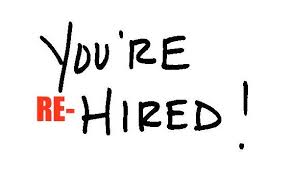








.webp?width=300&height=200&name=office-builing-main-lobby%20(27).webp)


-2.png)
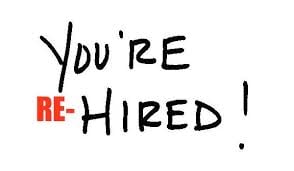






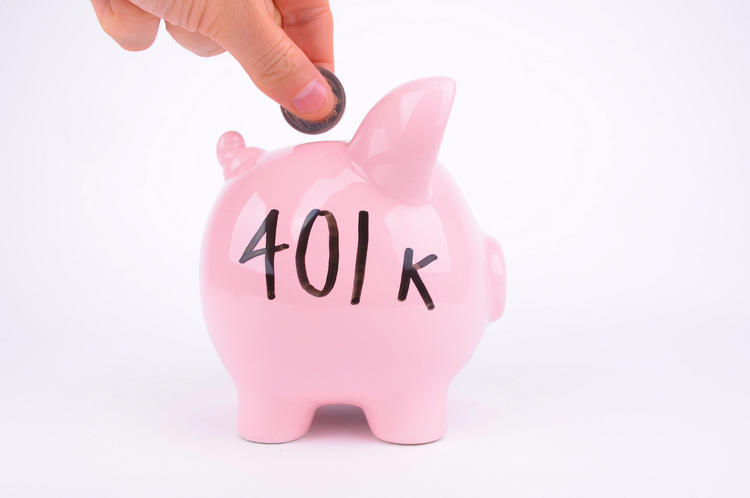

.webp)